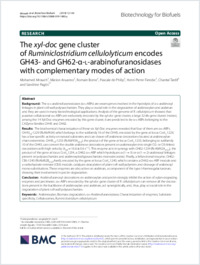The xyl-doc gene cluster of Ruminiclostridium cellulolyticum encodes GH43- and GH62-α-l-arabinofuranosidases with complementary modes of action.
- Mroueh M Aix Marseille Université, CNRS, LCB UMR7283, IMM-CNRS, 31 Chemin Joseph Aiguier, 13402 Marseille Cedex 20, France.
- Aruanno M 2Institute of Microbiology, Lausanne University Hospital, Lausanne, Switzerland.
- Borne R Aix Marseille Université, CNRS, LCB UMR7283, IMM-CNRS, 31 Chemin Joseph Aiguier, 13402 Marseille Cedex 20, France.
- de Philip P Aix Marseille Université, CNRS, LCB UMR7283, IMM-CNRS, 31 Chemin Joseph Aiguier, 13402 Marseille Cedex 20, France.
- Fierobe HP Aix Marseille Université, CNRS, LCB UMR7283, IMM-CNRS, 31 Chemin Joseph Aiguier, 13402 Marseille Cedex 20, France.
- Tardif C Aix Marseille Université, CNRS, LCB UMR7283, IMM-CNRS, 31 Chemin Joseph Aiguier, 13402 Marseille Cedex 20, France.
- Pagès S Aix Marseille Université, CNRS, LCB UMR7283, IMM-CNRS, 31 Chemin Joseph Aiguier, 13402 Marseille Cedex 20, France.
- 2019-06-15
Published in:
- Biotechnology for biofuels. - 2019
Arabinoxylan
Biomass degradation
Cellulosomes
Characterization of enzymes
Ruminiclostridium cellulolyticum
Substrate specificity
α-l-Arabinofuranosidase
English
Background
The α-l-arabinofuranosidases (α-l-ABFs) are exoenzymes involved in the hydrolysis of α-l-arabinosyl linkages in plant cell wall polysaccharides. They play a crucial role in the degradation of arabinoxylan and arabinan and they are used in many biotechnological applications. Analysis of the genome of R. cellulolyticum showed that putative cellulosomal α-l-ABFs are exclusively encoded by the xyl-doc gene cluster, a large 32-kb gene cluster. Indeed, among the 14 Xyl-Doc enzymes encoded by this gene cluster, 6 are predicted to be α-l-ABFs belonging to the CAZyme families GH43 and GH62.
Results
The biochemical characterization of these six Xyl-Doc enzymes revealed that four of them are α-l-ABFs. GH4316-1229 (RcAbf43A) which belongs to the subfamily 16 of the GH43, encoded by the gene at locus Ccel_1229, has a low specific activity on natural substrates and can cleave off arabinose decorations located at arabinoxylan chain extremities. GH4310-1233 (RcAbf43Ad2,3), the product of the gene at locus Ccel_1233, belonging to subfamily 10 of the GH43, can convert the double arabinose decorations present on arabinoxylan into single O2- or O3-linked decorations with high velocity (k cat = 16.6 ± 0.6 s-1). This enzyme acts in synergy with GH62-1234 (RcAbf62Am2,3), the product of the gene at locus Ccel_1234, a GH62 α-l-ABF which hydrolyzes α-(1 → 3) or α-(1 → 2)-arabinosyl linkages present on polysaccharides and arabinoxylooligosaccharides monodecorated. Finally, a bifunctional enzyme, GH62-CE6-1240 (RcAbf62Bm2,3Axe6), encoded by the gene at locus Ccel_1240, which contains a GH62-α-l-ABF module and a carbohydrate esterase (CE6) module, catalyzes deacylation of plant cell wall polymers and cleavage of arabinosyl mono-substitutions. These enzymes are also active on arabinan, a component of the type I rhamnogalacturonan, showing their involvement in pectin degradation.
Conclusion
Arabinofuranosyl decorations on arabinoxylan and pectin strongly inhibit the action of xylan-degrading enzymes and pectinases. α-l-ABFs encoded by the xyl-doc gene cluster of R. cellulolyticum can remove all the decorations present in the backbone of arabinoxylan and arabinan, act synergistically, and, thus, play a crucial role in the degradation of plant cell wall polysaccharides.
The α-l-arabinofuranosidases (α-l-ABFs) are exoenzymes involved in the hydrolysis of α-l-arabinosyl linkages in plant cell wall polysaccharides. They play a crucial role in the degradation of arabinoxylan and arabinan and they are used in many biotechnological applications. Analysis of the genome of R. cellulolyticum showed that putative cellulosomal α-l-ABFs are exclusively encoded by the xyl-doc gene cluster, a large 32-kb gene cluster. Indeed, among the 14 Xyl-Doc enzymes encoded by this gene cluster, 6 are predicted to be α-l-ABFs belonging to the CAZyme families GH43 and GH62.
Results
The biochemical characterization of these six Xyl-Doc enzymes revealed that four of them are α-l-ABFs. GH4316-1229 (RcAbf43A) which belongs to the subfamily 16 of the GH43, encoded by the gene at locus Ccel_1229, has a low specific activity on natural substrates and can cleave off arabinose decorations located at arabinoxylan chain extremities. GH4310-1233 (RcAbf43Ad2,3), the product of the gene at locus Ccel_1233, belonging to subfamily 10 of the GH43, can convert the double arabinose decorations present on arabinoxylan into single O2- or O3-linked decorations with high velocity (k cat = 16.6 ± 0.6 s-1). This enzyme acts in synergy with GH62-1234 (RcAbf62Am2,3), the product of the gene at locus Ccel_1234, a GH62 α-l-ABF which hydrolyzes α-(1 → 3) or α-(1 → 2)-arabinosyl linkages present on polysaccharides and arabinoxylooligosaccharides monodecorated. Finally, a bifunctional enzyme, GH62-CE6-1240 (RcAbf62Bm2,3Axe6), encoded by the gene at locus Ccel_1240, which contains a GH62-α-l-ABF module and a carbohydrate esterase (CE6) module, catalyzes deacylation of plant cell wall polymers and cleavage of arabinosyl mono-substitutions. These enzymes are also active on arabinan, a component of the type I rhamnogalacturonan, showing their involvement in pectin degradation.
Conclusion
Arabinofuranosyl decorations on arabinoxylan and pectin strongly inhibit the action of xylan-degrading enzymes and pectinases. α-l-ABFs encoded by the xyl-doc gene cluster of R. cellulolyticum can remove all the decorations present in the backbone of arabinoxylan and arabinan, act synergistically, and, thus, play a crucial role in the degradation of plant cell wall polysaccharides.
- Language
-
- English
- Open access status
- gold
- Identifiers
-
- DOI 10.1186/s13068-019-1483-y
- PMID 31198441
- Persistent URL
- https://folia.unifr.ch/global/documents/83017
Statistics
Document views: 17
File downloads:
- fulltext.pdf: 0
